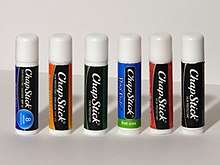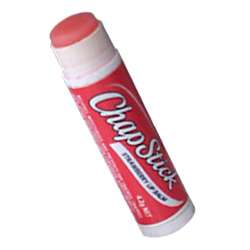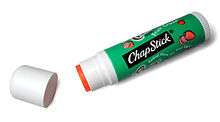ChapStick
ChapStick is a brand name of lip balm manufactured by Pfizer Consumer Healthcare and used in many countries worldwide. It is intended to help treat and prevent chapped lips, hence the name. Many varieties also include sunscreen in order to prevent sunburn.
 | |
 Variants of ChapStick lip balm | |
| Product type | Lip balm |
|---|---|
| Owner | Pfizer |
| Country | United States |
| Introduced | Early 1880s |
| Previous owners | Wyeth |
| Website | chapstick |

Due to its popularity, the term has become a genericized trademark. It popularly refers to any lip balm contained in a lipstick-style tube and applied in the same manner as lipstick. However, the term is still a registered trademark, with rights exclusively owned by Pfizer. Its main competitors in the US, Carmex and Blistex, also use the popular lipstick-style tube for their lip balm products. In Iceland and in the United Kingdom, the product's main competitor is Lypsyl, made by Novartis Consumer Health and distributed in similar packaging to ChapStick.
History
In the early 1880s, Charles Browne Fleet,[1] a physician and pharmacological thinker from Lynchburg, Virginia, invented ChapStick as a lip balm product. The handmade product, which resembled a wickless candle wrapped in tin foil, was sold locally, and did not have much success.[2]
In 1912, John Morton, also a Lynchburg resident, bought the rights to the product for five dollars. In their kitchen, Mrs. Morton melted the pink ChapStick mixture, cooled it, and cut it into sticks. Their lucrative sales were used to found the Morton Manufacturing Corporation.[2]
In 1935, Frank Wright, Jr., a commercial artist from Lynchburg, Virginia, was commissioned to design the CHET ChapStick logo that is still in use today. He was paid a one-off fee of $15.[2]
In 1963, The A.H. Robins Company acquired ChapStick from Morton Manufacturing Corporation. At that time, only ChapStick Lip Balm regular stick was being marketed to consumers; subsequently, many more varieties have been introduced. This includes ChapStick four flavored sticks in 1971, ChapStick Sunblock 15 in 1981, ChapStick Petroleum Jelly Plus in 1985, and ChapStick Medicated in 1992.
Robins was purchased by American Home Products (AHP) in 1988.[3] AHP later changed its name to Wyeth. ChapStick was a Wyeth product until 2009, when Wyeth was acquired by Pfizer. Pfizer sold the manufacturing facility in Richmond, Virginia, on October 3, 2011, to Fareva Richmond, who now manufactures and packages ChapStick for Pfizer.[4]
Composition

Ingredients commonly include camphor, beeswax, menthol, petrolatum, phenol, vitamin E, aloe and oxybenzone.[5] However, there are many variants of ChapStick, each with its own composition.
The full list of ingredients in a regular-flavored ChapStick is:
arachidyl propionate, camphor, carnauba wax, cetyl alcohol, D&C red no. 6 barium lake, FD&C yellow no. 5 aluminum lake, fragrance, isopropyl lanolate, isopropyl myristate, lanolin, light mineral oil, methylparaben, octyldodecanol, oleyl alcohol, paraffin, phenyl trimethicone, propylparaben, titanium dioxide, white wax, propanol.[6] Its net weight is usually 4 grams (0.14 oz).
When manufactured by Wyeth, Chapstick contained no parabens.
Uses
ChapStick functions as both a sunscreen, available with SPFs as high as 50, and a skin lubricant to help prevent and protect chafed, chapped, sunburned, cracked, and windburned lips. "Medicated" varieties also contain analgesics to relieve sore lips.
Marketing
ChapStick is sometimes available in special flavors developed in connection with marketing partners such as Disney (as in cross-promotions with Winnie the Pooh or the movie Cars) or with charitable causes such as breast cancer awareness, in which 30¢ is donated for each stick sold (as in the Susan G. Komen Pink Pack). The Flava-Craze line is marketed to preteens and young teens, with colorful applicators and "fun" flavors such as Grape Craze and Blue Crazeberry.
US Olympic skier Suzy Chaffee starred in ChapStick television commercials in which she dubbed herself "Suzy ChapStick". Another very famous ChapStick advertisement includes basketball legend Julius Erving (commonly known as Dr. J) naming himself Dr. ChapStick and telling young children about the great things that ChapStick can do.[7]
Diana Golden, a U.S. Olympic Gold medal winning skier and the 1988 Ski Racing Magazine and United States Olympic Committee female skier of the year, was also a spokesperson for ChapStick.[8] Former ski racer Picabo Street, for a time, was seen on television commercials as one of the company's endorsers.[9]
References
- "THE STORY OF CHAPSTICK". ChapStick. Archived from the original on 2018-01-03.
- Carpenter, Wanda (December 2015). "A Tinkering Pharmacist, an Artist, and "The World's Smartest Investment"". Lynchburg Museum Staff.
- "A.H. Robins Company - Virginia Historical Society A Guide to the A. H. Robins Company Records, 1885–2004". Archived from the original on 2017-12-01. Retrieved 2013-10-07.
- Sullivan, Heather. "Fareva plans to expand and create more jobs".
- Luciani, Jene (2013-05-15). "Can You Be Addicted to ChapStick?". Shape Magazine. Retrieved 2017-12-21.
- "LABEL: CHAPSTICK CLASSIC ORIGINAL- petrolatum stick". U.S. NATIONAL LIBRARY OF MEDICINE. September 2012.
- "Where Are They Now? Suzanne 'Suzy Chapstick' Chaffee, celebrity skier".
- "Disabled Ski Pioneer Diana Golden Dies - Skiing Magazine".
- Ettus, Samantha (October 27, 2011). "A Brand's Second Mistake: Where Does Lost Chapstick Go From Here?". Forbes. Retrieved 2017-12-21.
External links
| Wikimedia Commons has media related to ChapStick. |
- ChapStick – Official website
- ChapStick UK – Official UK website
- The History of Chapstick